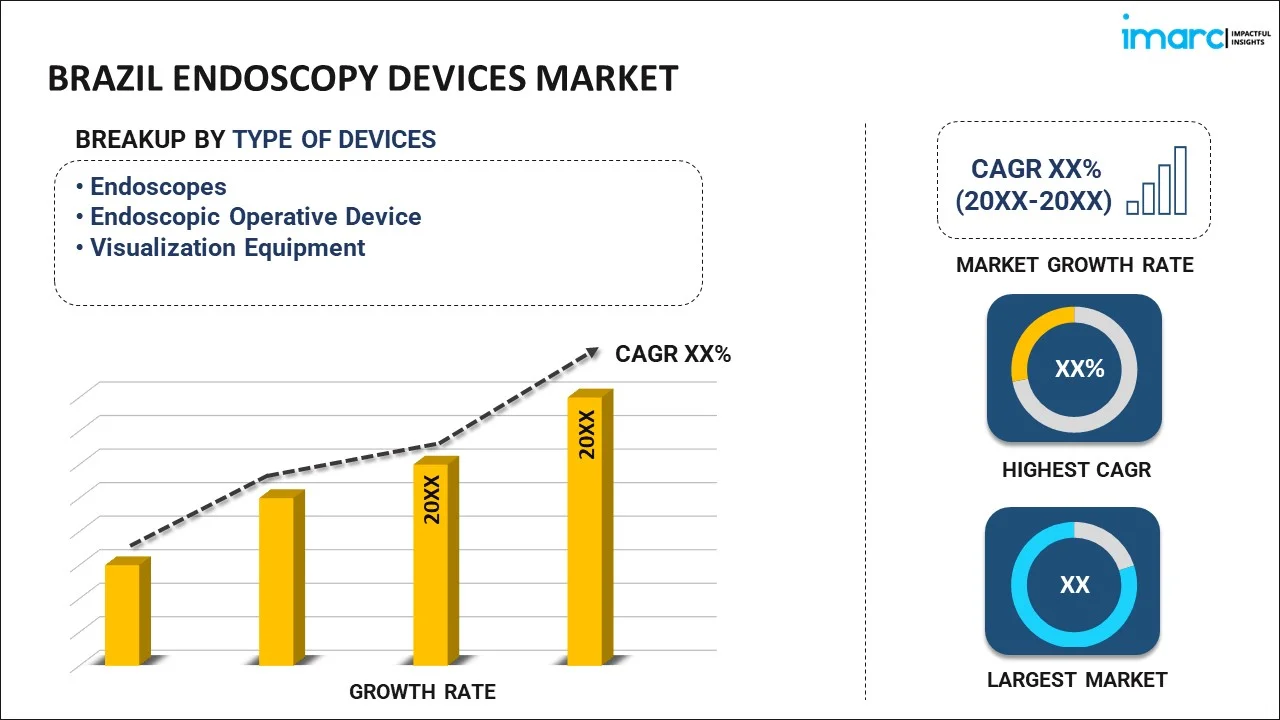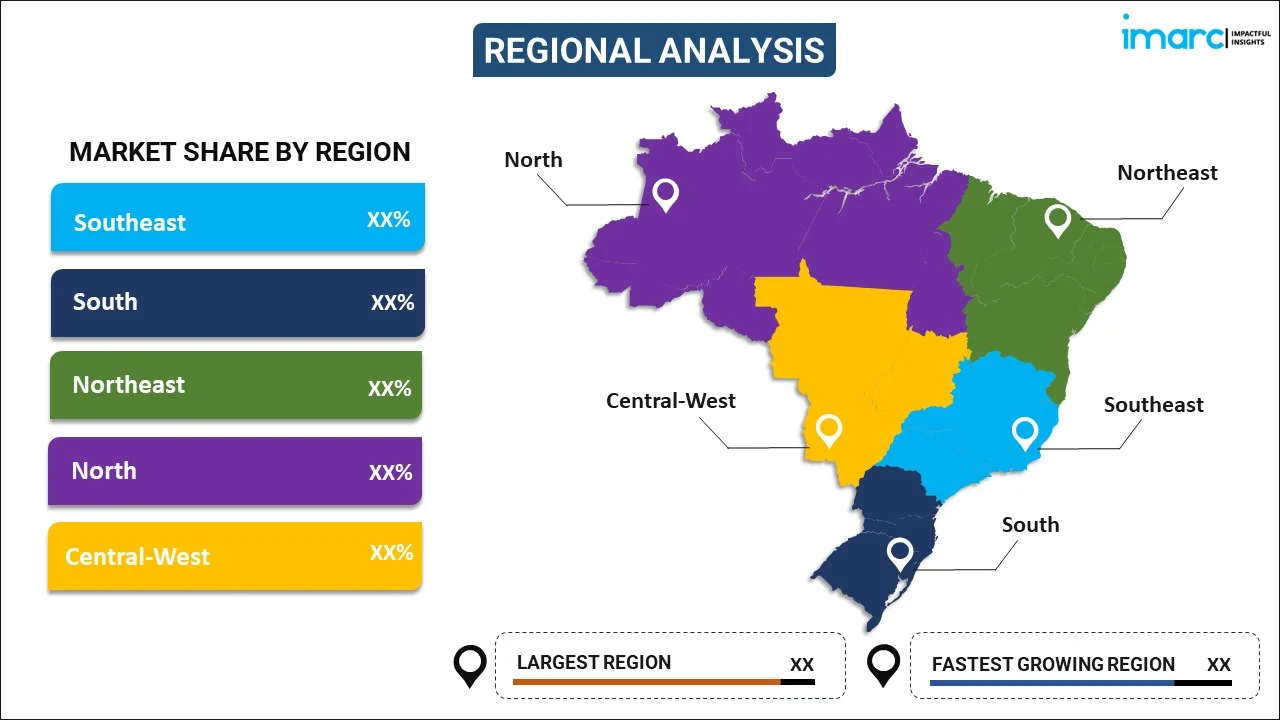
Brazil Endoscopy Devices Market Report by Type of Device (Endoscopes, Endoscopic Operative Device, Visualization Equipment), Application (Gastroenterology, Pulmonology, Orthopedic Surgery, Cardiology, Gynecology, and Others), and Region 2025-2033
Market Overview:
Brazil endoscopy devices market size is projected to exhibit a growth rate (CAGR) of 5.49% during 2025-2033. The rising prevalence of gastrointestinal disorders, significant advancements in endoscopic technology, increased healthcare access and escalating consumer awareness represent some of the key factors driving the market.
|
Report Attribute
|
Key Statistics
|
|---|---|
|
Base Year
|
2024 |
|
Forecast Years
|
2025-2033
|
|
Historical Years
|
2019-2024
|
| Market Growth Rate (2025-2033) | 5.49% |
Endoscopy devices are a class of medical instruments designed for the visual inspection and diagnostic examination of the body's internal organs and cavities. These devices play a critical role in modern healthcare by allowing minimally invasive (MI) procedures, reducing the need for traditional open surgeries, and enabling physicians to visualize and diagnose a wide range of medical conditions. Endoscopy devices consist of a long, flexible, or rigid tube equipped with a high-resolution camera and light source, which can be inserted into the body through natural openings or small incisions. This camera captures real-time images and videos of the internal structures, such as the digestive tract, respiratory system, urinary tract, or joints, and transmits them to a monitor for a detailed examination. Endoscopy devices often include additional channels for the introduction of specialized tools to perform procedures like biopsies, polyp removal, or the treatment of various conditions. The field of endoscopy continues to advance with innovations in optics, imaging technology, and minimally invasive surgical techniques, making it an essential component of modern medical practice.
Brazil Endoscopy Devices Market Trends:
The rising prevalence of gastrointestinal disorders in Brazil, such as colorectal cancer and inflammatory bowel diseases, has created a growing demand for endoscopy procedures, including colonoscopies and gastroscopies, thereby fueling the market growth. Besides this, with a rapid increase in the aging population of Brazil, there's a surge in incidences of age-related conditions, including gastrointestinal issues and various cancers, which is further driving the need for endoscopy devices for timely diagnosis and intervention. Moreover, significant advancements in endoscopy technology have made these devices more efficient and accessible and innovations like high-definition imaging, improved maneuverability, and better patient comfort have boosted the popularity of endoscopic procedures, thereby strengthening the market growth. Concurrent with this, increased healthcare access and awareness have led to more individuals seeking medical services, including endoscopy procedures, creating a favorable outlook for market expansion. Additionally, numerous government initiatives and investments in healthcare infrastructure have expanded the reach of endoscopy services to underserved areas, which is presenting lucrative opportunities for market expansion. In confluence with this, the growing adoption of endoscopy devices as safer and more efficient alternatives to traditional surgeries to minimize exposure and reduce hospitalization times is providing an impetus to the market growth. Furthermore, changing dietary habits and lifestyle factors like unhealthy diets, sedentary lifestyles, and alcohol consumption have led to an increase in gastrointestinal diseases in Brazil, boosting the demand for endoscopic evaluations and treatments, which is aiding in market expansion. Apart from this, the development of specialized endoscopic procedures for weight loss, such as bariatric endoscopy, has created a niche market within the broader field of endoscopy, which in turn, is presenting lucrative opportunities for market expansion.
Brazil Endoscopy Devices Market Segmentation:
IMARC Group provides an analysis of the key trends in each segment of the market, along with forecasts at the country level for 2025-2033. Our report has categorized the market based on type of device and application.
Type of Device Insights:

- Endoscopes
- Rigid Endoscope
- Flexible Endoscope
- Capsule Endoscope
- Robot-assisted Endoscope
- Endoscopic Operative Device
- Irrigation/Suction System
- Access Device
- Wound Protector
- Insufflation Device
- Others
- Visualization Equipment
- Endoscopic Camera
- SD Visualization System
- HD Visualization System
The report has provided a detailed breakup and analysis of the market based on the type of device. This includes endoscopes (rigid endoscope, flexible endoscope, capsule endoscope, and robot-assisted endoscope), endoscopic operative device (irrigation/suction system, access device, wound protector, insufflation device, and others), and visualization equipment (endoscopic camera, SD visualization system, and HD visualization system).
Application Insights:
- Gastroenterology
- Pulmonology
- Orthopedic Surgery
- Cardiology
- Gynecology
- Others
A detailed breakup and analysis of the market based on the application have also been provided in the report. This includes gastroenterology, pulmonology, orthopedic surgery, cardiology, gynecology, and others.
Regional Insights:

- Southeast
- South
- Northeast
- North
- Central-West
The report has also provided a comprehensive analysis of all the major regional markets, which include Southeast, South, Northeast, North, and Central-West.
Competitive Landscape:
The market research report has also provided a comprehensive analysis of the competitive landscape in the market. Competitive analysis such as market structure, key player positioning, top winning strategies, competitive dashboard, and company evaluation quadrant has been covered in the report. Also, detailed profiles of all major companies have been provided. Some of the key players include:
Brazil Endoscopy Devices Market Report Coverage:
| Report Features | Details |
|---|---|
| Base Year of the Analysis | 2024 |
| Historical Period | 2019-2024 |
| Forecast Period | 2025-2033 |
| Units | US$ Million |
| Scope of the Report | Exploration of Historical Trends and Market Outlook, Industry Catalysts and Challenges, Segment-Wise Historical and Future Market Assessment:
|
| Type of Devices Covered |
|
| Applications Covered | Gastroenterology, Pulmonology, Orthopedic Surgery, Cardiology, Gynecology, Others |
| Regions Covered | Southeast, South, Northeast, North, Central-West |
| Customization Scope | 10% Free Customization |
| Report Price and Purchase Option | Single User License: US$ 3699 Five User License: US$ 4699 Corporate License: US$ 5699 |
| Post-Sale Analyst Support | 10-12 Weeks |
| Delivery Format | PDF and Excel through Email (We can also provide the editable version of the report in PPT/Word format on special request) |
Key Questions Answered in This Report:
- How has the Brazil endoscopy devices market performed so far and how will it perform in the coming years?
- What has been the impact of COVID-18 on the Brazil endoscopy devices market?
- What is the breakup of the Brazil endoscopy devices market on the basis of type of device?
- What is the breakup of the Brazil endoscopy devices market on the basis of application?
- What are the various stages in the value chain of the Brazil endoscopy devices market?
- What are the key driving factors and challenges in the Brazil endoscopy devices?
- What is the structure of the Brazil endoscopy devices market and who are the key players?
- What is the degree of competition in the Brazil endoscopy devices market?
Key Benefits for Stakeholders:
- IMARC’s industry report offers a comprehensive quantitative analysis of various market segments, historical and current market trends, market forecasts, and dynamics of the Brazil endoscopy devices market from 2019-2033.
- The research report provides the latest information on the market drivers, challenges, and opportunities in the Brazil endoscopy devices market.
- Porter's five forces analysis assist stakeholders in assessing the impact of new entrants, competitive rivalry, supplier power, buyer power, and the threat of substitution. It helps stakeholders to analyze the level of competition within the Brazil endoscopy devices industry and its attractiveness.
- Competitive landscape allows stakeholders to understand their competitive environment and provides an insight into the current positions of key players in the market.
Need more help?
- Speak to our experienced analysts for insights on the current market scenarios.
- Include additional segments and countries to customize the report as per your requirement.
- Gain an unparalleled competitive advantage in your domain by understanding how to utilize the report and positively impacting your operations and revenue.
- For further assistance, please connect with our analysts.
 Inquire Before Buying
Inquire Before Buying
 Speak to an Analyst
Speak to an Analyst
 Request Brochure
Request Brochure
 Request Customization
Request Customization




.webp)




.webp)












